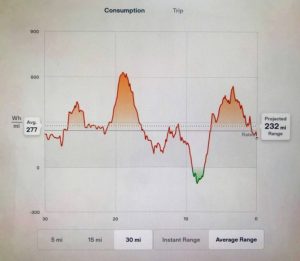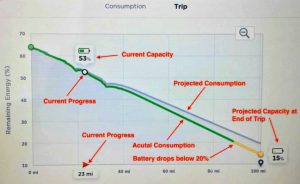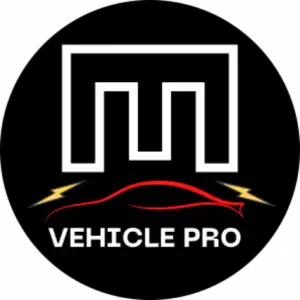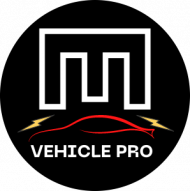Don’t Fear Range Anxiety:
Tips for Tesla Owners
Drivers with range anxiety worry that their EV will run out of power before they can plug it in – and it’s quite common among new Tesla owners. Don’t worry – an expanding charging infrastructure, energy-efficient technology and a few simple energy-saving strategies can conserve your range – and your peace of mind.
Are you worried about your Tesla electric vehicle running out of power before you can plug in again? If so, you may be suffering from ‘range anxiety’. Breathe. You can easily overcome range anxiety with a few tips from our Tesla experts at EVehiclePro.
What is Range Anxiety?
Range anxiety is the fear that your electric vehicle will run out of power before reaching its destination or a charging station. Range anxiety is very real for many new EV owners and is an emotional response linked to some common EV myths.
I used to start panicking when I noticed that my battery was under 25% and I was still an hour from home. Now I know that’s more than enough to get me home or to a Supercharger.
If you have range anxiety, use the stress-busting tips our Tesla experts have developed, as you build confidence and learn to love your Tesla even more!
Signs of Range Anxiety
Many new Tesla owners need to acclimate to a new way of “re-fuelling”, and build confidence with how far their vehicle will go. This may initially feel daunting and contribute to anxiety.
Like all forms of anxiety, range anxiety can cause uncomfortable emotions and physical symptoms. EV owners may show some of these signs of range anxiety:
- fear about not making it to their destination
- continuously checking battery level and projected range
- inability to shift thoughts away from worries about range
- avoiding or delaying driving or long road trips
- irritability
- over-charging battery >90%
Some may also experience physical symptoms like:
- sweating and hot flashes
- clammy hands
- jaw clenching
- shallow breathing
I used to worry all the time about my range, but now I remind myself about how efficient my vehicle really is. I also have a regular charging routine and my driving experience has given me a ton of confidence!
How to Reduce Range Anxiety: Top Tips
Some of our Tesla drivers have experienced range anxiety, so we know what it feels like. Relax! Our team put together a comprehensive list of tips to help you have a stress-free drive.
EVPro Tip: If your anxiety becomes overwhelming, seek support from your health care team.
Here’s how to reduce your range anxiety:
1. Replace Anxious Thoughts with Facts
Anxiety can lead to obsessive and ruminating negative thoughts.
What if I don’t make it to my destination? What if I get stranded on the road? What if I can’t find a charging station, or they’re full? What if the temperature drops?
Before you panic, get the facts. Sometimes, stressful emotions are linked to fear and myths. Replacing our anxious thoughts with factual information can put the brakes on, and help stop our minds from running away with unfounded worries.
I’ve learned that there isn’t really a difference between heading to a gas station when you’re at a 1/4 tank of fuel, and navigating to a Supercharger when you’re under 25%.
When you’re feeling anxious, remind yourself of these facts about your EV’s range:
Fact: Teslas have excellent ranges
Teslas offer impressive ranges, often exceeding 300 miles (482 km) on a single charge – that’s often more than a tank of gas in a traditional car!
When you’re feeling anxious, remind yourself that your vehicle can probably go further than a tank of gas goes for most internal combustion engine vehicles.
Fact: Chargers are everywhere
Does the thought of a long road trip or rural traveling make you panic? Remind yourself that charging stations are everywhere. In fact, EV charging stations are on the way to being as commonplace as gas stations. Tesla has invested heavily in building an enormous Supercharger network, which gives owners access to more than 130,000 chargers in the US alone. So, not only can Tesla owners charge at Tesla Superchargers but can also charge at any public charging station, with the right adaptor.
EVPro Tip: Reduce range anxiety even more by carrying an adaptor. This enables you to charge at several non-Tesla stations and offers great peace of mind! We recommended a CCS – a popular after-market adapter that gives Tesla owners the greatest access to most non-Tesla charging stations.
Fact: Teslas are fine in cold weather using a few easy strategies
It’s true that cold temperatures can increase energy demands on an EV’s battery, reduce regenerative braking and contribute to reduced range.
However, it’s easy to minimize the drain with a few simple tips:
- precondition
- keep your vehicle plugged in
- adapt a few easy winter driving tips
Fact: Teslas are energy-efficient
Remind yourself that your Tesla has the most energy-efficient technology available to conserve your range. Even when you are worried, your vehicle is working to conserve energy with features like regenerative braking, Chill Mode, and high-efficiency batteries. Tesla S Models can go over 400 miles on a single charge, and long-range models have superior efficiency for longer-distance drivers.
2. Don’t Guess: Use Tesla’s Energy App
Are your worrisome thoughts still running away from you? Check in with your vehicle’s real-time data by using your Tesla’s Energy App. It estimates your predicted energy usage – and your actual range is probably better than what you think! Your Tesla Energy app also gives you personalized suggestions on how to conserve or extend your range.
To open the Energy app:
- Click on the 3 dots at the bottom middle of your screen to open up the app page
- Click on the Energy icon

There are two charts in the Energy app:
- Consumption Chart: This will display how much energy your Tesla has consumed over the past 5, 15 or 30 miles (10, 25 or 50 km).
When Average Range is selected, your Tesla will use the last 5, 15 or 30 miles (10, 25 or 50 km) of usage to most accurately predict the range of your Tesla.
The shaded red areas on the chart represent energy used. The shaded green area is energy recovered during regenerative braking.
When Instant Range is selected, your Tesla will only use the last few minutes to predict the range. EV Pro Tip: We recommend using Average Range for the most accurate range prediction.

- Trip Chart: When you enter a destination into your Tesla, the Trip Chart will become active. This line chart is used to monitor the amount of energy being used while driving to your destination. You will know that Trip Chart is active when a grey line appears on the screen.
The left side of the grey line represents your vehicle’s energy at the start of your trip; the right side of the grey line is the predicted energy remaining in your vehicle upon arrival at your destination.
As you drive, a green line will appear. The green line will show your actual usage, giving you the most accurate prediction of your energy level as your trip progresses.

3. Conserve Energy with these Easy Tips
Reduce your range anxiety by adapting a few tips to conserve your range. Although Tesla vehicles have built-in features to conserve your range, there are several additional ways for you to make your drives even more efficient.
These are the best ways to boost your battery and conserve your range:
When you realize how easy it is to charge your vehicle and how far you actually can go, your confidence will grow. Trust us when we say your range anxiety will disappear quickly.
- Use Tesla’s trip planner and navigation system
Tesla’s built-in navigation system is designed to help you reach your destination efficiently while accounting for necessary charging stops. Simply input your destination, and the system will calculate the optimal route, including Supercharger locations and estimated charging times.
Rest assured that you will get to your destination using the most energy-efficient route, with options to charge quickly and smoothly if needed.
- Ease off on the brake
Tesla vehicles come with a feature called regenerative braking, which recovers energy during deceleration and returns it to the battery.
By easing off the accelerator pedal and allowing the vehicle to slow down naturally, you can extend your vehicle’s range.
- Establish a charging routine
Plan a charging routine that fits your lifestyle, whether that means charging overnight at home, during the day at work, or at convenient locations while running errands.
Expect a longer trip? Plan to use Tesla’s every-expanding Supercharger network, which offers the fastest charging.
Familiarize yourself with destination chargers – slightly slower charging stations that are located at many hotels and restaurants. Plug in while you’re having lunch at your favorite restaurant. - Plan routes with charging stations in mind
Tesla’s navigation system will guide you to Superchargers, but you can also consult third-party apps and websites to locate additional charging options. These apps provide peace of mind and ensure that you have a backup plan in case a charging station is unavailable or out of service.
EVPro Tip: Your Tesla will notify you if a Supercharger station is out of service, so that you can navigate to the next available one. - Carry an adapter
You don’t need an adapter to charge your Tesla at a Tesla Supercharger. However, as the non-Tesla charging infrastructure expands, you may wish to carry an adapter to access more chargers, for extra peace of mind.
CCS is a popular after-market adapter that gives Tesla owners the greatest access to most non-Tesla charging stations.
- Adjust your driving habits
Your driving style can significantly impact your Tesla’s range. To conserve energy, avoid rapid acceleration by using Chill Mode, maintain a consistent speed, and use autopilot when possible. In addition, driving at a slightly slower speed can have a notable impact on your vehicle’s overall range. - Enable or disable certain features
Conserve power by disabling energy-using features such as Sentry Mode, and enabling energy-conserving features like Chill Mode.
EVPro Tip: Be aware that certain features like Sentry Mode will automatically disable when the battery goes below 20%. - Be prepared for unexpected situations
Sometimes, unforeseen circumstances may affect your Tesla’s range or access to charging stations. Always keep a buffer of extra charge as a safety margin, and familiarize yourself with backup options, such as destination charging at hotels or restaurants.
EVPro Tip: Panicking because you’re in a real pinch? If you’re at your last few miles and need to conserve your range urgently, use our “tips in a pinch” to extend your range until you can plug-in.
4. Breathe
We all know that slow, deep breaths help to lower physical and emotional stress. If you’re experiencing anxiety because you’re worried about range or other things, take 2-3 slow breaths and feel the stress melting away. Drop your anxiety even more by streaming some ‘spa music’ from one of Tesla’s many music options, or belt out some stress-busting tunes with the caraoke feature!
5. Stay Informed and Connected
As a Tesla owner, one of the best ways to manage your anxiety is by subscribing to our monthly newsletter, Tesla Connect. Let us help you enjoy a stress-free driving experience! Relax and…
- Get the latest Tesla updates
With Tesla Connect, you’ll be the first to know about software updates, new features, and improvements that can enhance your vehicle’s performance and capabilities and reduce range anxiety.
- Gain valuable tips and tricks
Each issue of Tesla Connect includes practical advice and tips from Tesla experts and experienced owners, helping you get the most out of your vehicle. Learn how to optimize your range, maintain your Tesla, and discover hidden features that can make your driving experience even more enjoyable. - Read our reviews
Our real Tesla drivers use our experience to save you time, money and stress. We share our honest and comprehensive reviews of several products and features to help you decide on the best products and features for your Tesla.
- Access exclusive savings
Subscribers to Tesla Connect are privy to exclusive special promotions and discounts. We have obtained special discounts for our Tesla Connect readers from many trusted websites.
Thinking about a Tesla EV? The EVehiclePro team has got your back with loads of expert advice and honest reviews for new and seasoned Tesla drivers. Join the Tesla Connect community on social media and sign up for our newsletter with helpful tips and exclusive coupon codes for great savings!
By implementing these tips and staying connected through our newsletter, you’ll find that range anxiety becomes a thing of the past, allowing you to love your Tesla even more!
FAQ
Can I upgrade my Tesla’s battery to increase its range?
While it’s not possible to upgrade your Tesla’s battery to increase its range, there are other options to consider if you’re concerned about range anxiety. If you haven’t purchased your Tesla yet, or if you’re considering a new one, it’s worth exploring the Long Range model variants. These versions come with larger battery capacities for an extended range and anxiety-free driving.
Why do I get less range in my Tesla then was stated?
The Environmental Protection Agency (EPA) provides an estimated range for electric vehicles, based on standardized testing procedures. These are the ranges that Tesla posts for its vehicles. EPA-rated ranges are not real-world ranges though, and don’t take into account factors such as weather, driving style and terrain.
How accurate are the ranges for Tesla vehicles?
While the stated EPA-rated ranges are a helpful baseline, actual range can vary depending on factors such as temperature, driving conditions, and vehicle load. Some Tesla drivers may experience ranges close to or even exceeding EPA estimates, while others may find their range slightly lower in certain situations.
What is a destination charger?
A destination charger is a Level 1 station that charges your EV at the slowest speed. Although slower than Level 2 or Level 3 (Superchargers), these convenient chargers allow Tesla drivers to charge their vehicles while they spend time at popular destinations, such as restaurants or hotels.
How can I find Tesla-compatible destination charging stations?
Tesla’s in-car navigation system and website provide information on destination charging locations. Additionally, third-party apps like ABRP (A Better Route Planner), PlugShare and ChargePoint can help you find Tesla-compatible destination charging stations.
How can I plan a long trip in my Tesla to ensure I have enough range?
Use Tesla’s in-car navigation system to plan your route. This will take into account your vehicle’s current range, available charging stations, and inform you of estimated charging times.
Telsa also has a trip planning website called “Go anywhere” that works similarly to the in-car navigation system. Note that the website assumes that you will start your trip with a full charge.
Can I adjust the level of regenerative braking in my Tesla?
Drivers can no longer adjust the level of regenerative braking in their Tesla. A Tesla software update removed this feature in 2021.
How much does a Tesla’s battery degrade over time?
Battery degradation varies depending on factors such as usage, charging habits, and environmental conditions. Tesla’s own data show Model S and X batteries retain about 90 per cent of their original capacity over an average of 200,000 miles of use.
What can I do to minimize battery degradation in my Tesla?
To minimize battery degradation, follow Tesla’s charging guidelines. Avoid frequent fast charging (such as daily supercharging) and maintain a moderate state of charge (between 20% and 80%).
How much does it cost to charge a Tesla at a Supercharger?
The cost of charging a Tesla at a Supercharger station varies depending on the location of the Supercharger station, the state or country you are in, and the time of day you are charging. Generally, Tesla charges per kWh (kilowatt-hour) of electricity used, and the rate varies between $0.28 to $0.36 per kWh in the United States.
The exact cost of charging at a Supercharger station can be determined through the in-car navigation system, which will display the current price per kWh at the Supercharger station you plan to use.
Some Superchargers offer time-based pricing in certain regions, which means that the price may vary based on the length of your charging session.
EVPro Tip: Don’t leave your EV plugged into a supercharger any longer than needed. Not only is it poor supercharging etiquette, but it will cost you in idling fees.





